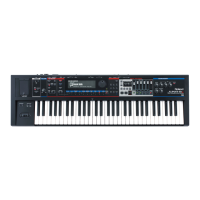63
Overview
Appendix
USB Memory
Song Player
Digital Recorder
Synthesizer
Selecting Sounds Perform. Functions Editing/Eects Other Settings
Rec/Play/Edit Eects Rhythm Pattern
41: LIMITER
Compresses signals that exceed a specied volume level, preventing distortion from
occurring.
L in
R in
L out
R out
Limiter
2-Band EQ
2-Band EQ
Limiter
Parameter Value Explanation
Release # 0–127
Adjusts the time after the signal
volume falls below the Threshold
Level until compression is no
longer applied.
Threshold # 0–127
Adjusts the volume at which
compression begins
Ratio 1.5:1, 2:1, 4:1, 100:1 Compression ratio
Post Gain 0–+18 dB Adjusts the output gain.
Low Gain -15–+15 dB Gain of the low range
High Gain -15–+15 dB Gain of the high range
Level # 0–127 Output Level
42: GATE
Cuts the reverb’s delay according to the volume of the sound sent into the eect. Use
this when you want to create an articial-sounding decrease in the reverb’s decay.
L in
R in
L out
R out
Gate
Gate
Parameter Value Explanation
Threshold # 0–127
Volume level at which the gate
begins to close
Mode
Type of gate
GATE
The gate will close when the
volume of the original sound
decreases, cutting the original
sound.
DUCK (Ducking)
The gate will close when the
volume of the original sound
increases, cutting the original
sound.
Attack 0–127
Adjusts the time it takes for the
gate to fully open after being
triggered.
Hold 0–127
Adjusts the time it takes for the
gate to start closing after the
source sound falls beneath the
Threshold.
Release 0–127
Adjusts the time it takes the gate
to fully close after the hold time.
Balance # D100:0W–D0:100W
Volume balance between the
direct sound (D) and the eect
sound (W)
Level 0–127 Output Level
43: DELAY
This is a stereo delay.
When Feedback Mode is NORMAL:
R in
R out
L in
L out
Feedback
Feedback
Balance W
Balance W
2-Band
EQ
2-Band
EQ
Delay
Delay
When Feedback Mode is CROSS:
R in
R out
L in
L out
Feedback
Feedback
Balance W
Balance W
2-Band
EQ
2-Band
EQ
Delay
Delay
Parameter Value Explanation
Delay Left
0–1300 msec, note
Adjusts the time until the delay
sound is heard.
Delay Right
Phase Left
Phase of the left delay sound
NORMAL Non-inverted
INVERT Inverted
Phase Right
Phase of the right delay sound
NORMAL Non-inverted
INVERT Inverted
Feedback Mode NORMAL, CROSS
Selects the way in which delay
sound is fed back into the eect.
(See the gures above.)
Feedback # -98–+98%
Adjusts the amount of the delay
sound that’s fed back into the
eect. Negative (-) settings invert
the phase.
HF Damp 200–8000 Hz, BYPASS
Adjusts the frequency above
which sound fed back to the
eect is ltered out. If you don’t
want to lter out any high
frequencies, set this parameter
to BYPASS.
Low Gain -15–+15 dB Gain of the low range
High Gain -15–+15 dB Gain of the high range
Balance # D100:0W–D0:100W
Volume balance between the
direct sound (D) and the delay
sound (W)
Level 0–127 Output Level

